A) $20; $27.33
B) $10; $10.40
C) $24; $27.33
D) $30; $20.50
Correct Answer

verified
Correct Answer
verified
Multiple Choice
Suppose that a pure monopolist can sell 5 units of output at $4 per unit and 6 units at $3.90 per unit. For the monopolist to profitably produce and sell the sixth unit of output, its marginal cost must be anywhere at or below
A) $4.
B) $3.90.
C) $3.50.
D) $3.40.
Correct Answer

verified
Correct Answer
verified
Multiple Choice
The higher prices charged by monopolists
A) are like a private tax that redistributes income from consumers to monopoly sellers.
B) are socially optimal because they better reflect how much society values the good relative to the resources used to produce it.
C) return to consumers through the public goods provided by monopolies.
D) have no effect on the distribution of income.
Correct Answer

verified
Correct Answer
verified
Multiple Choice
The MR = MC rule
A) applies only to pure competition.
B) applies only to pure monopoly.
C) does not apply to pure monopoly, because price exceeds marginal revenue.
D) applies both to pure monopoly and pure competition.
Correct Answer

verified
Correct Answer
verified
Multiple Choice
A monopoly is most likely to emerge and be sustained when
A) output demand is relatively elastic.
B) firms have U-shaped average-total-cost curves.
C) fixed capital costs are small relative to total costs.
D) economies of scale are large relative to market demand.
Correct Answer

verified
Correct Answer
verified
Multiple Choice
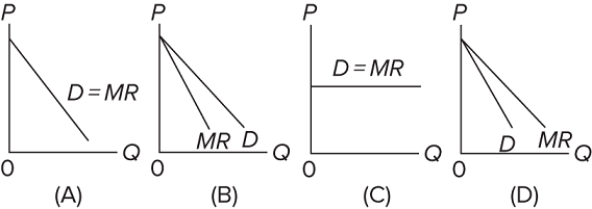 Which of the diagrams correctly portrays the demand (D) and marginal revenue (MR) curves of a purely competitive seller?
Which of the diagrams correctly portrays the demand (D) and marginal revenue (MR) curves of a purely competitive seller?
A) A
B) B
C) C
D) D
Correct Answer

verified
Correct Answer
verified
Multiple Choice
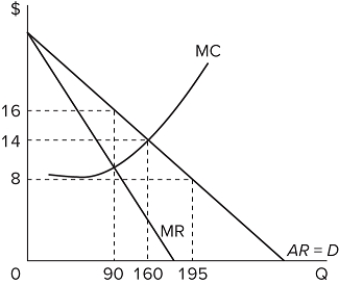 If the industry depicted in this graph operated as a pure monopoly, the output quantity would be
If the industry depicted in this graph operated as a pure monopoly, the output quantity would be
A) 90.
B) 160.
C) 195.
D) a level that is not labeled in the graph.
Correct Answer

verified
Correct Answer
verified
Multiple Choice
If a regulatory commission wants to provide a natural monopoly with a fair return, it should establish a price that is equal to
A) minimum average fixed cost.
B) average total cost.
C) marginal cost.
D) marginal revenue.
Correct Answer

verified
Correct Answer
verified
Multiple Choice
 Refer to the demand and cost data for a pure monopolist given in the table. An unregulated, nondiscriminating monopolist would earn maximum profits of
Refer to the demand and cost data for a pure monopolist given in the table. An unregulated, nondiscriminating monopolist would earn maximum profits of
A) $420.
B) $70.
C) $190.
D) $360.
Correct Answer

verified
Correct Answer
verified
Multiple Choice
What do economies of scale, the ownership of essential raw materials, and patents have in common?
A) They must all be present before price discrimination can be practiced.
B) They are all barriers to entry.
C) They all help explain why a monopolist's demand and marginal revenue curves coincide.
D) They all help explain why the long-run average cost curve is U-shaped.
Correct Answer

verified
Correct Answer
verified
Multiple Choice
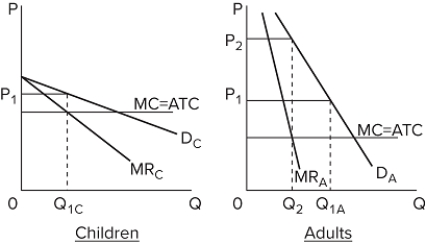 Assume the figure applies to a pure monopolist and that MC is the same for both graphs. If this firm is able to price discriminate between children and adults, it should charge prices of
Assume the figure applies to a pure monopolist and that MC is the same for both graphs. If this firm is able to price discriminate between children and adults, it should charge prices of
A) P₁ to children and P₂ to adults.
B) P₁ to adults and P₂ to children.
C) P₁ to both children and adults.
D) P₂ to both children and adults.
Correct Answer

verified
Correct Answer
verified
Multiple Choice
A nondiscriminating pure monopolist finds that it can sell its 82nd unit of output for $12. We can surmise that the marginal
A) cost of the 82nd unit is also $12.
B) revenue of the 82nd unit is also $12.
C) revenue of the 82nd unit is less than $12.
D) revenue of the 82nd unit is greater than $12.
Correct Answer

verified
Correct Answer
verified
Multiple Choice
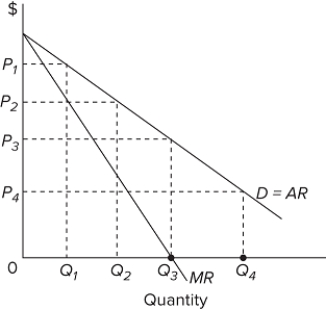 Refer to the graph, which shows the revenue curves for a monopolist. If it wants to sell quantity Q₁, it must charge at price
Refer to the graph, which shows the revenue curves for a monopolist. If it wants to sell quantity Q₁, it must charge at price
A) P₁.
B) P₂.
C) 0.
D) The correct price is not labeled on the graph.
Correct Answer

verified
Correct Answer
verified
Multiple Choice
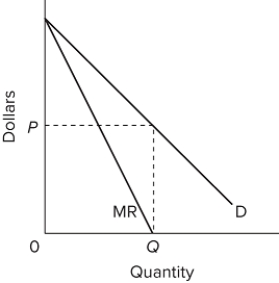 Assume a pure monopolist is charging price P and selling output Q, as shown on the diagram. On the basis of this information, we can say that
Assume a pure monopolist is charging price P and selling output Q, as shown on the diagram. On the basis of this information, we can say that
A) if marginal costs were somehow zero, the firm would be maximizing its profits.
B) if marginal costs were positive, the firm would increase profits by reducing price and selling more output.
C) the firm is producing where the price elasticity coefficient is less than one.
D) the firm is a "price taker."
Correct Answer

verified
Correct Answer
verified
Multiple Choice
Which of the following does not necessarily apply to a pure monopoly?
A) The product the firm produces must have no close substitutes.
B) The firm must be the sole producer of a product.
C) The firm will charge the highest price possible.
D) Entry must be blocked.
Correct Answer

verified
Correct Answer
verified
True/False
Successful price discrimination requires that buyers charged the different prices be physically separated.
Correct Answer

verified
Correct Answer
verified
Multiple Choice
Many people believe that monopolies charge any price they want to without affecting sales. In fact, the output and sales level for a profit-maximizing monopoly is codetermined with price where
A) marginal cost = average revenue.
B) marginal revenue = average cost.
C) average total cost = average revenue.
D) marginal cost = marginal revenue.
Correct Answer

verified
Correct Answer
verified
Multiple Choice
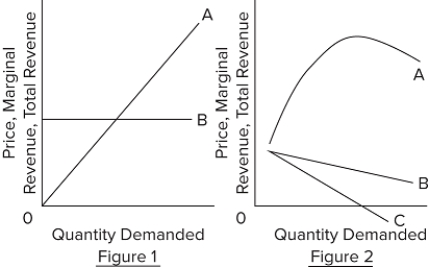 Refer to the two diagrams for individual firms. Line A represents the firm's
Refer to the two diagrams for individual firms. Line A represents the firm's
A) total revenue in Figure 1 and average revenue in Figure 2.
B) demand curve in both figures.
C) marginal revenue in Figure 1 and total revenue in Figure 2.
D) total revenue curve in both figures.
Correct Answer

verified
Correct Answer
verified
Multiple Choice
 Refer to the demand and cost data for a pure monopolist given in the table. If the monopolist were forced to produce the socially optimal output through the imposition of a ceiling price, the ceiling price would have to be set at
Refer to the demand and cost data for a pure monopolist given in the table. If the monopolist were forced to produce the socially optimal output through the imposition of a ceiling price, the ceiling price would have to be set at
A) $100.
B) $150.
C) $200.
D) $250.
Correct Answer

verified
Correct Answer
verified
Multiple Choice
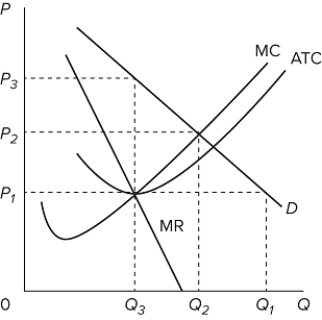 Refer to the cost and demand curves for a pure monopolist. Suppose that this monopoly is subjected to a regulatory commission. If the commission seeks to achieve the most efficient allocation of resources for this industry, it should set the socially optimal price at
Refer to the cost and demand curves for a pure monopolist. Suppose that this monopoly is subjected to a regulatory commission. If the commission seeks to achieve the most efficient allocation of resources for this industry, it should set the socially optimal price at
A) P₁.
B) P₂.
C) P₃.
D) 0.
Correct Answer

verified
Correct Answer
verified
Showing 161 - 180 of 407
Related Exams